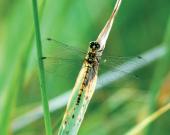
Dragonflies belong to the order Odonata, derived from the Greek meaning “toothed-jaw.” Odonata as a taxonomic order of class Insecta is divided into two suborders: damselflies (Zygoptera) and dragonflies (Anisoptera). Dragonflies and damselflies are closely related but show some physical differences. Damselflies are much smaller in body size and are more delicately structured; dragonflies are larger, swift-flying insects with voracious appetites. Another distinguishing feature is the difference in which the two groups position their wings when at rest. Dragonflies hold their wings outstretched at right angles to their body while damselflies fold their wings roof-like together, parallel to the body. There are many taxonomic divisions further along until we finally get to the individual species, but on the whole dragonflies and damselflies together are known as dragonflies, or in scientific language Odonata.
Adult dragonflies are among Saskatchewan’s most beautiful insects. Since they fly only during daylight times, the sun accentuates the colours of their bodies and their beautifully patterned wings when they hover or fly. Saskatchewan has a variety of aquatic environments ranging from alkaline lakes, sloughs and rivers, to acidic boreal bogs, fens and ponds. While large in extent, the range of wetlands in Saskatchewan is relatively low in diversity; therefore the species diversity of dragonflies is also low: the province has sixty-eight species of Odonata—twenty-two species of damselflies and forty-six species of dragonflies—as compared to approximately 650 species for the rest of North America. However, in this large area of wetlands, Saskatchewan’s low diversity is countered by the sheer volume of dragonflies on the wing. These all-important wetlands are where the dragonfly’s life begins and ends, and where most of their activities take place.
Dragonflies are strong fliers because the flight muscles are directly attached to four individual net-veined wings. This individual wing attachment is found in only a few groups of insects. Dragonflies have mastered the use of their muscled wings and they are able to hover, fly backwards and go from a full-stop position to rapid speeds almost instantly. Dragonflies have had a very long time to evolve such specialized flying techniques, considering that their fossil records go back over 300 million years to the Carboniferous Period.
Dragonflies begin their life cycle as “nymphs.” When hatched, these nymphs are squat, flattened, gill-breathing creatures that crawl in aquatic vegetation, mud or sand. They may stay in this nymph stage from one to five years. When the nymphs are ready to transform into adults, they pick a lily pad, a tall cat-tail plant or other object to crawl out of the water, and then shed their final outer exoskeleton and become fully winged adults. This process takes several hours to complete, and as dragonflies are very prone to dangers at this time, they usually emerge at night or in the early morning.
Once their wings have hardened enough to support flight, they take to the air with their newly found aerial freedom. As they grow, they shed their skin ten to fifteen times; these stages are called “instars.” The nymphs feed on all types of aquatic invertebrates including tadpoles and small fish, which may be done by either ambushing or stalking their prey. Even as nymphs, these “swimming dragons” possess deadly equipment for capturing their prey: they are endowed with an extendible lower toothed lip that shoots out, grasps, and then retracts the prey back to awaiting jaws.
Dragonflies are very beneficial to humans as they feed upon mosquitoes, black flies, and other blood-sucking insects usually found at fresh water sites; but these “dragons of the airways” are not discriminatory in their taste and are known to feed on other beneficial insects, including each other. After spending years as mud-crawling nymphs, they may last only days before being eaten by Birds or smashed on vehicle windshields; but if they are able to continue on their own, they may last up to six or eight weeks, patrolling over wet lands or hawking over nearby open fields. The males patrol the shores of these waters in anticipation of finding a receptive female to mate with and renew the cycle once again. The females stay away from the water except to oviposit their eggs and to mate, never actively patrolling near aquatic environments.
Gordon Hutchings
Print EntryHOME | BROWSE BY SUBJECT | ENTRY LIST (A-Z) | IMAGE INDEX | CONTRIBUTOR INDEX | ABOUT THE ENCYCLOPEDIA | SPONSORS TERMS OF USE | COPYRIGHT © 2006 CANADIAN PLAINS RESEARCH CENTER, UNIVERSITY OF REGINA | POWERED BY MERCURY CMS |
|||
| This web site was produced with financial assistance provided by Western Economic Diversification Canada and the Government of Saskatchewan. |
|||
 |
 |
 |
 |
| Ce site Web a été conçu grâce à l'aide financière de Diversification de l'économie de l'Ouest Canada et le gouvernement de la Saskatchewan. |
|||